![]()
|
Ridgways |
|
Location and period of operation:
|
Ridgways |
Shelton |
late
1879 |
1920 |
Earthenware
manufacturer at the Bedford
works,
Shelton, Hanley, Stoke-on-Trent,
England
|
Formerly: Ridgway, Sparks & Ridgway (1873-1879)
Subsequently: Ridgways (Bedford Works) Ltd (1920-1952)
Ridgways
Bedford Works, Stoke-on-Trent, Staffordshire
Manufacturers of Printed Ware of all descriptions, Decorated Table and Toilet Ware, Stone,
Jasper, Jet, and Porous Goods, also of Majolica and Green Glaze
The Pottery Gazette, American and Canadian Edition, January 1st 1880
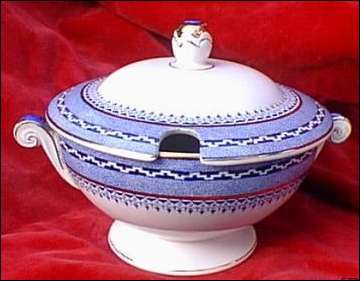
Ridgways Tureen
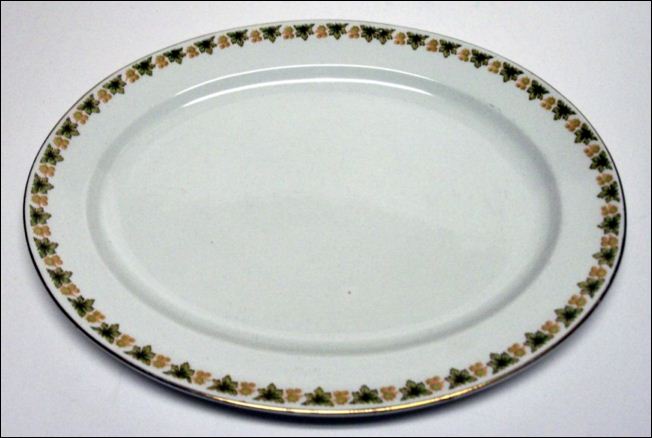
Ridgways platter in the MELBA
pattern
other companies used the name 'MELBA'
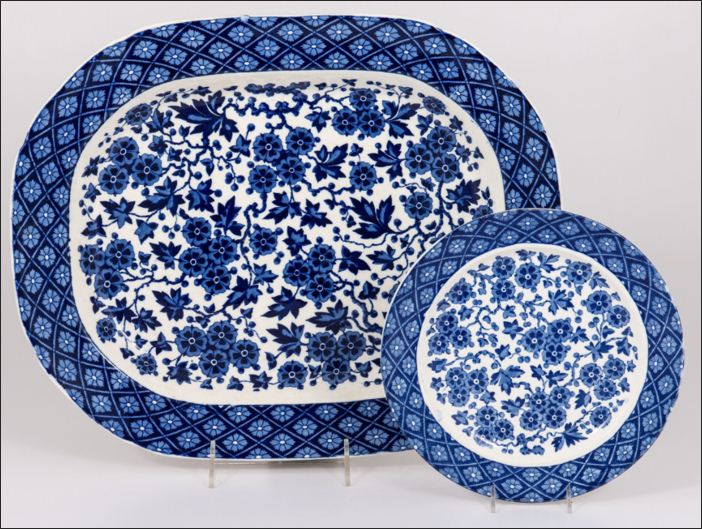 platter and plate in the popular transfer-ware Hawthornden pattern this pattern (number 4/7583) was
introduced by the predecessor Ridgway,
Sparks & Ridgway the Hawthornden pattern was widely
produced - mostly as |
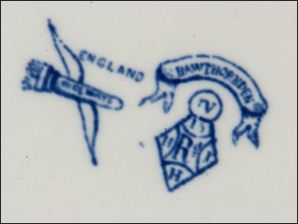 the registration diamond shows that the pattern was registered by Ridgways on the 15th April 1880 |
ware in the aesthetic style
more on the aesthetic style
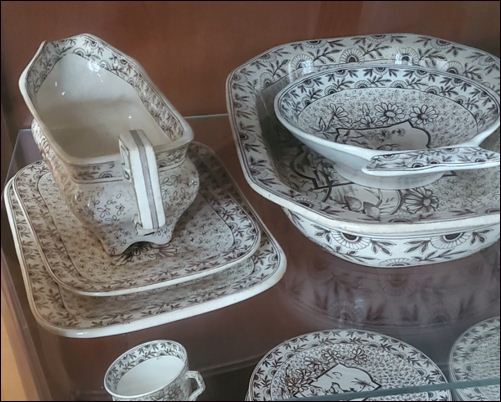
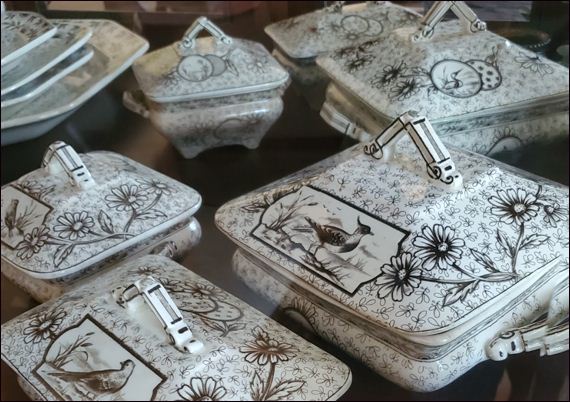
monochrome transferware dinner set in the
Devonshire Pattern
photos courtesy: Penny
LoPresto
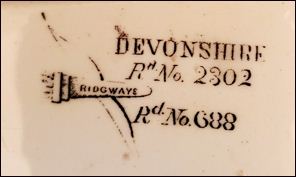 Devonshire Ridgways The bow and quiver mark without any place name was generally used around 1880-1885 Shape: the registration number 688 shows the shape of the dinner set was registered on the 23rd January 1884 Pattern: the number 2302 shows that the pattern was registered on the 22nd February 1884 to J & E A Ridgway |
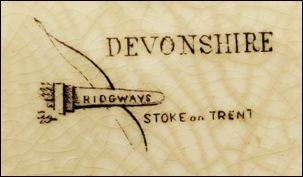 Devonshire Ridgways Stoke-on-Trent
this mark with
Stoke-on-Trent was |
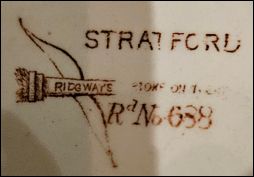 Stratford Ridgways Stoke-on-Trent
this mark with
Stoke-on-Trent was the registration number 688 is for the shape Stratford is the pattern name and is |
| both
of these Devonshire marks were used on various pieces of the same dinner set shown above |
|
the
pattern was produced in this polychrome pattern as well photo courtesy: Gail Shepherd |
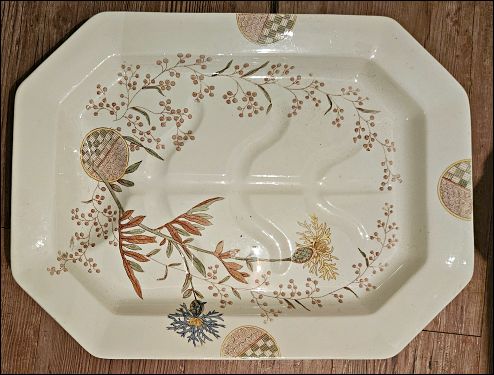 Stratford pattern photo courtesy: Lynette Whitby |
|
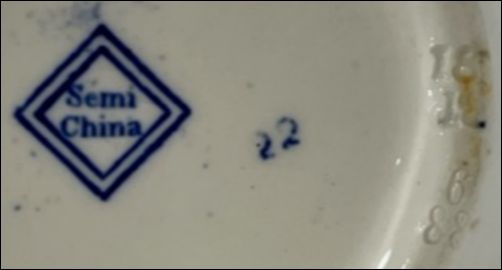 typical Ridgways diamond 'semi china' mark The impressed 6/88 will be the month/year of manufacture - June 1888. The other impressed number is either a shape/size number or a workman’s number, similarly the blue 22 will likely be the decorators mark. |
photos courtesy: Heidi Bates
|
a popular Ridgway pattern, based on the Muscat grape |
the impressed 6-94 indicates that the |
photos courtesy: Janet White
Marks used on ware for identification:
|
This was the first Ridgway business to use "Ridgways" (in the plural) prior to this the identification were initials or "Ridgway". |
Bow & Quiver marks:-
The bow and quiver trade mark was registered by Ridgways in 1880.
|
|

|
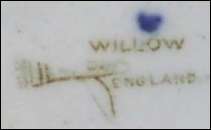
|
|
Bow and quiver mark without any place name is generally c.1880-1885 - however this is not a had and fast rule as the example registered in April 1887 shows |
Bow and quiver mark with 'Stoke-on-Trent' is generally c.1885-1890 |
Bow and quiver mark with 'England' c.1891+
|
| the use of the bow and quiver mark continued after 1920 - when the business was incorporated as Ridgway (Bedford Works) Ltd - usually the bow and quiver mark was then associated with the diamond mark |
Diamond marks:-
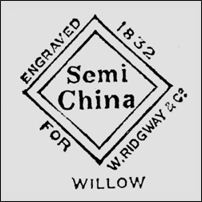
| Godden's Encyclopaedia
of British Pottery and Porcelain Marks gives a date of c.
1927 for the introduction of the diamond mark (mark 3317) this has been found to be incorrect - the following examples show that variations of the diamond mark were in use at least as early as 1885 and probably from the formation of the company in 1879/80... |
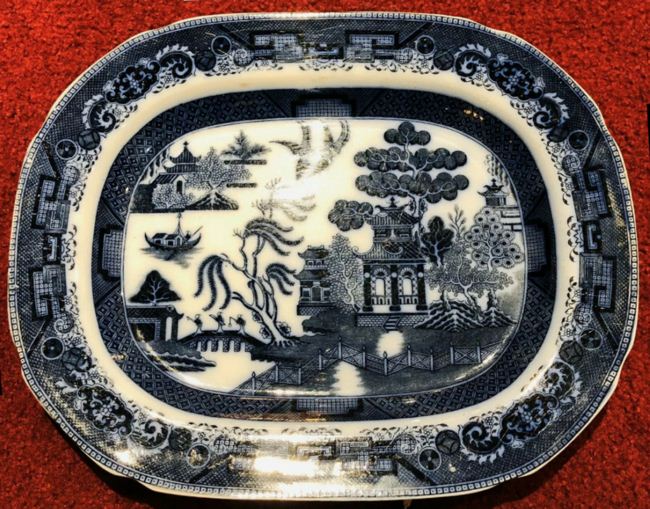 large platter in the Willow pattern |
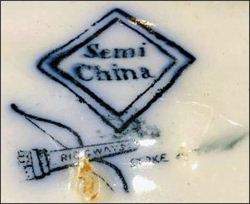 Semi China Ridgways Stoke-on-Trent Bow and quiver mark with 'Stoke-on-Trent' was used c.1885-1890 |
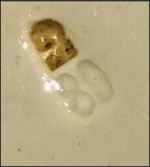 impressed date mark giving the month/year of manufacture - in this instance 2/89 for February 1889 |
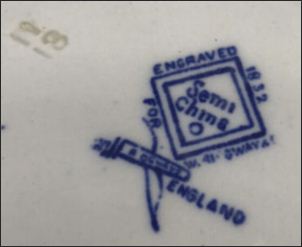 the impressed date mark gives the month/year of manufacture - in this instance 11/13 for November 1913 |
NOTE: The wording 'Engraved for W.Ridgway & Co 1832' refers to the fact that the pattern was first produced in 1832 by one of the former companies William Ridgway & Co. who operated in this period. It does not mean that this ware was made in 1832 |
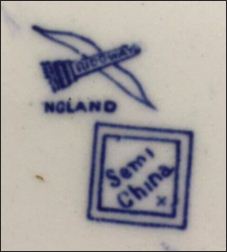
this mark is c. 1891+ (as it includes 'ENGLAND')
(it is not known what the small
cross
in the bottom corner signifies)
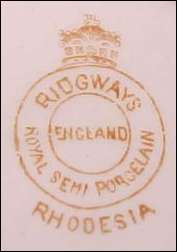 Ridgways Royal Semi Porcelain England |
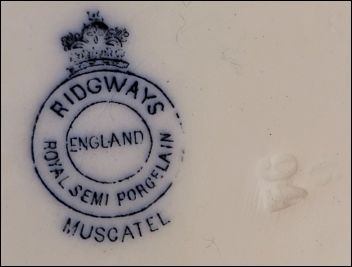 the impressed 6-94 indicates that this ware was made in June 1894 |
the pattern name is often
included
Godden's Encyclopaedia of
British Pottery & Porcelain Marks
gives a date of 1905+ for the introduction of this style of mark
however the impressed 6-94 would indicate that it was in use
as early as 1894

Ridgways
Vitrified
England
c.1912 +
the pattern name is often included
Reproduction of
earlier patterns and marks:
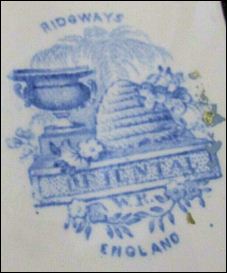 Ridgways W. R. England |
Certain patterns and printed
marks of William Ridgway and William
Ridgway & Sons were reissued at later periods by this subsequent
company Ridgways at the Bedford Works.
|
The Bedford Works
- click for more information -
Questions, comments, contributions? email: Steve Birks
|
Page created 15 October 2022 Updated 07 June 2023:- Page tidied up; Details on Devonshire pattern updated. Updated 22 Aug 2024:- Section on marks expanded. Updated 21 Aug 2025:- Stratford pattern added.
|